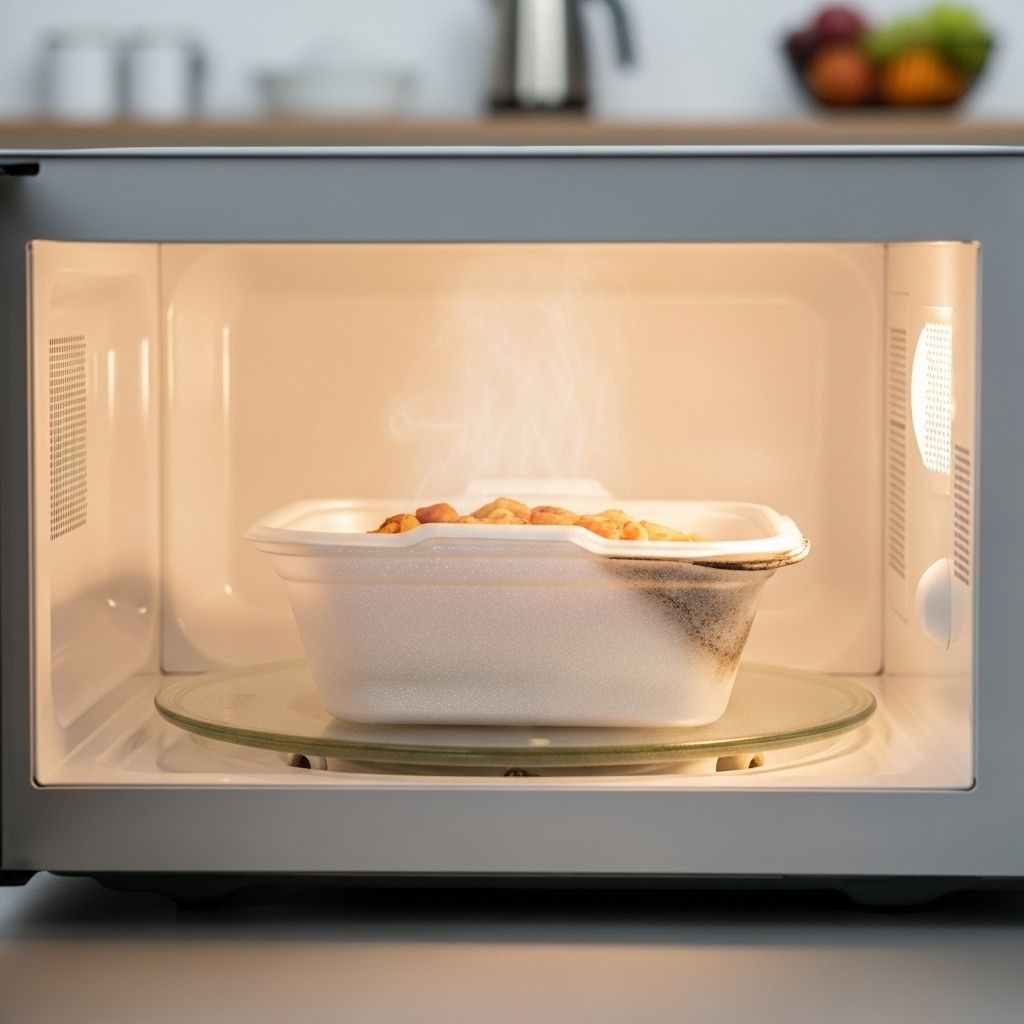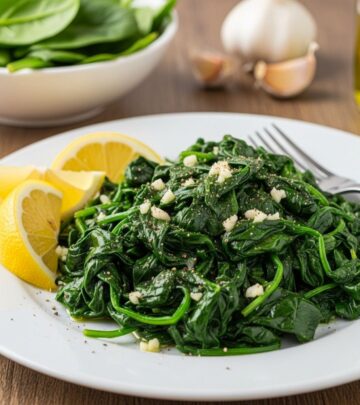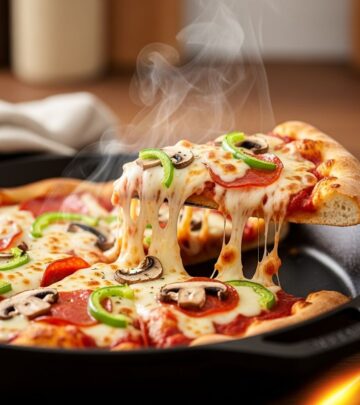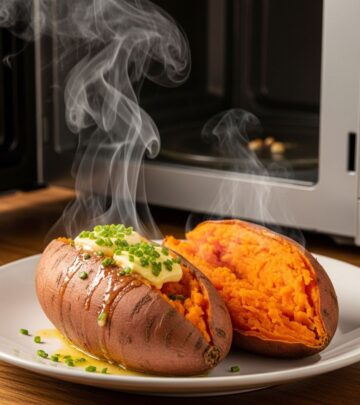Is Styrofoam Microwave Safe? Essential Guide To Food Safety
Get the facts on microwaving Styrofoam: what’s safe, what’s not, and how to heat up leftovers the right way.

Image: HearthJunction Design Team
Can You Microwave Styrofoam? The Complete Guide to Food Safety
If you often reach for takeout or store leftovers in lightweight foam containers, you may wonder: Can you safely microwave Styrofoam? Reheating yesterday’s dinner is convenient, but understanding the safety implications of microwaving this common packaging is vital for your health and peace of mind.
Table of Contents
- What Is Styrofoam?
- Styrofoam vs. Expanded Polystyrene (EPS): What’s the Difference?
- Can You Microwave Styrofoam?
- Potential Health Risks of Microwaving Styrofoam
- What Makes Some Styrofoam ‘Microwave-Safe’?
- Best Practices for Reheating Food
- Environmental Impact & Alternatives
- Frequently Asked Questions
What Is Styrofoam?
Although most people refer to disposable coffee cups and takeout boxes as “Styrofoam,” there’s a technical distinction worth noting. Styrofoam is actually a trademarked brand name from the Dow Chemical Company, used specifically for their extruded polystyrene foam products, which are primarily designed for building insulation and industrial uses. What we typically call Styrofoam in food packaging is actually expanded polystyrene foam (EPS)—a lightweight, air-filled plastic foam that is about 95% air and designed for single-use packaging and containers.
- Trademark: Styrofoam is not a general term but a registered brand for building materials.
- Food Packaging: Most foam food containers are made from EPS (expanded polystyrene), not true Styrofoam.
- Material: Both are made from polystyrene plastic, but differ in how they’re manufactured and used.
Styrofoam vs. Expanded Polystyrene (EPS): What’s the Difference?
Understanding what your food container is made of helps clarify the safety considerations when microwaving.
| Feature | Styrofoam (Extruded Polystyrene) | EPS (Expanded Polystyrene) |
|---|---|---|
| Main Use | Construction, insulation | Food packaging, cups, coolers |
| Appearance | Blue or green boards, rigid | White, bead-like texture, lightweight |
| Manufacturing | Extruded into sheets | Expanded beads pressed into molds |
| Trademark | Yes (Dow Chemical) | No |
So, when people ask about microwaving “Styrofoam,” they usually mean EPS foam food containers.
Can You Microwave Styrofoam?
The short answer: Only if it is clearly labeled microwave-safe. If your EPS food container or cup doesn’t say it’s safe for microwave use, do not heat food or drink in it.
- FDA Guidance: According to the U.S. Food and Drug Administration (FDA), most polystyrene containers used for food packaging are safe for their intended purposes, including holding hot and cold foods.
- Heat Sensitivity: Polystyrene foam can melt, warp, or leach chemicals when exposed to high microwave heat.
- Safety Labels: Only use foam containers that carry a “microwave-safe” symbol or explicit labeling.
- General Rule: No label? Don’t microwave it.
“You should only microwave food in Styrofoam containers that have a microwave-safe label. This is to prevent the compound styrene, which has been linked to possible health risks, from leaching into food.”
– Healthline
While it may seem convenient to heat up leftovers in their original container, not every takeout box or foam cup is designed for the high temperatures a microwave can generate. When EPS foam is exposed to heat, it can break down and potentially release harmful chemicals into your food.
Commonly Used Non-Microwave-Safe Items
- Takeout containers with no labeling
- Single-use foam coffee cups
- Clamshell containers and trays
Potential Health Risks of Microwaving Styrofoam
Polystyrene foam contains two main chemicals: styrene and benzene. Both are petroleum derivatives that contribute to foam’s lightweight, insulating structure, but raise some concerns when heated:
- Melted Foam: When EPS is heated above its threshold (around 212°F/100°C), it can soften, melt, and leach chemicals into food.
- Leaching Risk: Styrene, in particular, may transfer from the foam into foods and beverages, especially at high temperatures. Research links high levels of styrene exposure to possible health issues, though typical consumer exposures are considered very low.
- FDA Position: The FDA classifies food-grade polystyrene as safe for food use, but only within intended parameters (i.e., not heated unless labeled).
Heating foam containers that are not designed for microwave use may also risk melting and damaging your food, as well as causing unpleasant odors or even minor fires in extreme cases.
What Makes Some Styrofoam ‘Microwave-Safe’?
Some foam products are manufactured and tested to withstand microwave heating and are specifically labeled as “microwave-safe.” To earn this designation, products must pass FDA guidelines that determine they will not leach harmful levels of chemicals into food during regular microwave use.
- Labeling Is Key: Look for containers with the “microwave-safe” symbol—usually a set of wavy lines or the words ‘microwave safe’ molded into the bottom.
- Testing: Microwave-safe containers are tested to ensure that, under typical conditions, they do not break down, melt, or release unsafe levels of chemicals.
- Limitations: Even microwave-safe foam may not withstand repeated or extreme heating—only use within manufacturer guidelines.
How To Identify Microwave-Safe Containers
- Check for a label: “Microwave-safe” wording or a microwave symbol.
- Inspect material: If in doubt, transfer food to glass or ceramic dishware for heating.
- Avoid damaged containers: Chipped, cracked, or melting foam is unsafe for microwave use.
Best Practices for Reheating Food
If you’re unsure whether your takeout container can withstand microwave heat, follow these safe reheating tips:
- Transfer to microwave-safe dishware: Glass and ceramic plates or bowls are best for reheating.
- Use microwave-safe lids or wraps: Avoid plastic wrap or lids that can melt. Use vented microwave covers when possible.
- Reheat in short intervals: To avoid overheating, heat food in 30-60 second bursts, stirring in between.
- Avoid overheating: Excessive microwave times can damage even safe containers.
- Check for container integrity: If foam becomes soft, warped, or emits an odor during microwaving, stop immediately.
These simple practices help reduce chemical exposure and keep your food tasting its best.
Environmental Impact & Alternatives
While foam containers offer convenience, they come with a significant environmental footprint:
- Non-Biodegradable: EPS foam is not naturally biodegradable and persists in the environment for centuries.
- Recycling Challenges: Few local programs accept foam for recycling, and it’s often contaminated with food residues.
When possible, opt for reusable or recyclable containers. Many restaurants now offer compostable or paper-based packaging. Bringing your own glass or stainless-steel food storage containers can also help reduce waste.
Eco-Friendly Alternatives to Foam
- Glass food storage containers
- Ceramic mugs and bowls
- Reusable silicone food wraps
- Paper-based or compostable takeout containers
Frequently Asked Questions
Q: What happens if I accidentally microwave regular Styrofoam?
A: If you heat a non-microwave-safe foam container, it may soften, melt, or deform. More importantly, it could leach small amounts of styrene or other chemicals into your food, especially with hot, oily, or acidic dishes. If you notice melting or a chemical smell, discard the food and container.
Q: How can I tell if my food container is microwave-safe?
A: Look for a ‘microwave-safe’ label or wavy-line symbol, typically molded into the bottom of the container. When in doubt, transfer the food to a glass or ceramic plate before microwaving.
Q: Is drinking coffee from a foam cup safe?
A: Food-grade foam cups are generally considered safe for holding hot beverages, but repeated use or prolonged exposure to high heat is not recommended. For microwave heating, only use foam cups labeled as microwave-safe.
Q: Are bamboo or paper containers safer for microwaving?
A: Paper and bamboo containers are generally safer in the microwave than foam, as they lack the chemicals used in polystyrene. However, always check for microwave-safe labeling, as coatings or adhesives can sometimes react to heat.
Q: Can Styrofoam catch fire in the microwave?
A: While rare, if heated beyond its melting point or exposed to direct heat from microwave elements, polystyrene foam could catch fire. This is more likely if the container is empty or nearly empty.
Q: Is Styrofoam recyclable?
A: In most communities, EPS foam is not accepted in curbside recycling programs due to contamination and processing challenges. Check with local facilities for drop-off options.
Key Takeaways
- Only microwave foam containers if they are explicitly labeled as ‘microwave-safe.’
- Transfer food to glass or ceramic dishware for reheating whenever possible.
- Avoid microwaving containers that are damaged, deformed, or unlabeled.
- Consider eco-friendly alternatives to foam for both health and environmental benefits.
Conclusion
Microwaving foam containers remains a common kitchen question. While FDA-approved, microwave-safe EPS containers are permitted for heating, many takeout boxes and cups are not designed for microwave use and can leach chemicals or melt when heated. When in doubt, always transfer food to a microwave-safe dish, and prioritize reusable or recyclable containers to protect both your health and the environment.
For more kitchen safety tips and food storage advice, explore our guides on microwave-safe materials and best practices for leftovers.
References
- https://www.allrecipes.com/article/can-you-microwave-styrofoam/
- https://www.tasteofhome.com/article/can-you-microwave-styrofoam/
- https://www.allrecipes.com/gallery/microwave-uses/
- https://www.healthline.com/nutrition/can-you-microwave-styrofoam
- https://www.mrappliance.com/blog/2019/march/can-you-put-styrofoam-in-the-microwave-reheat-fo/
Read full bio of medha deb












